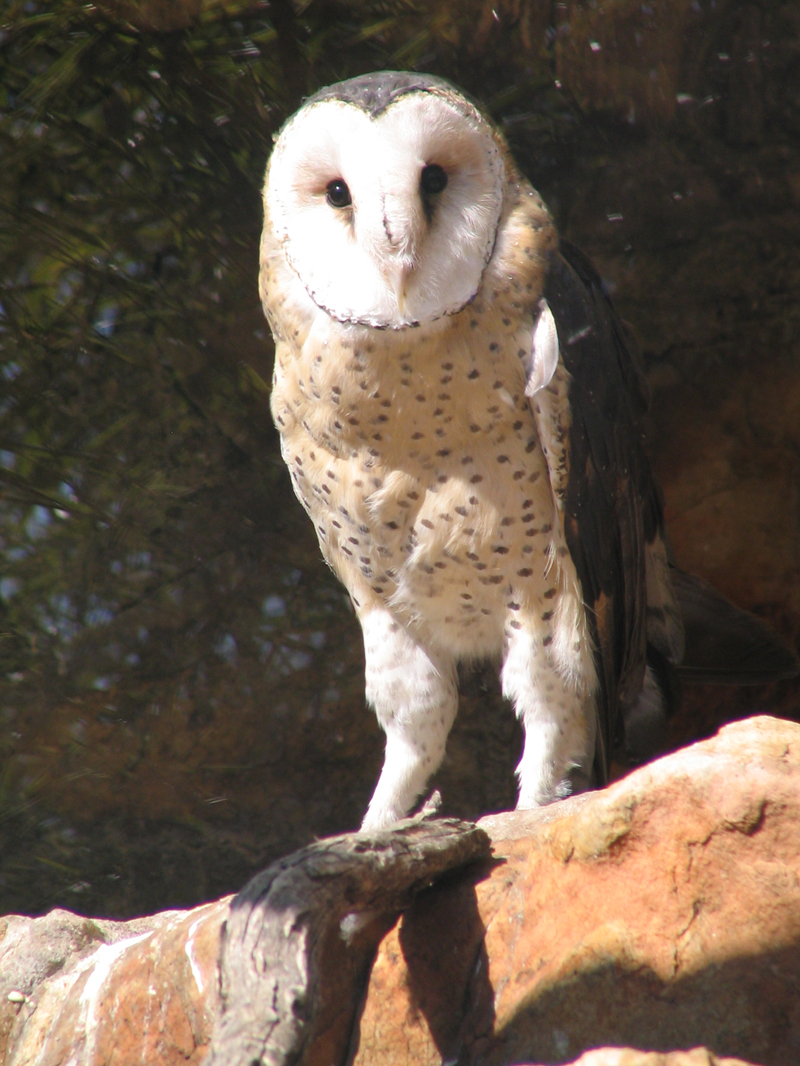- Tyto
Taxobox
fossil_range =Late Miocene - Recent
name = "Tyto"

image_width = 200px
image_caption =African Grass-owl , "Tyto capensis" The "grass-owls" are two rather long-legged species of "Tyto".
regnum =Animalia
phylum =Chordata
classis =Aves
subclassis =Neornithes
infraclassis =Neognathae
superordo =Neoaves
ordo =Strigiformes
familia =Tytonidae
subfamilia = Tytoninae
subfamilia_authority =
genus = "Tyto"
genus_authority = Billberg, 1828
subdivision_ranks =Species
subdivision = About 15, see text
synonyms = "Lechusa" Miller, 1956
"Strix" "sensu auct. non" Linnaeus, 1758 - preoccupiedThe
genus "Tyto" includes allbarn-owl s (family Tytonidae) except for thebay-owl s (subfamily Phodilinae, genus "Phodilus") - that is, the true barn-owls, the grass-owls and the masked-owls collectively making up thesubfamily Tytoninae. They are darker on the back than the front, usually an orange-brown colour, the front being a paler version of the back or mottled, although there is considerable variation even amongst species. "Tyto" owls have a divided, heart-shaped facial disc, and lack the ear-like tufts of feathers found in many other owls. "Tyto" owls tend to be larger than Bay-owls.Throughout their
evolution ary history, "Tyto" owls have shown a better capability to colonize islands than other owls. Several such island forms have becomeextinct , some long ago, but some in comparatively recent times. A number of insular barn-owls from theMediterranean and theCaribbean were very large or truly gigantic species.ystematics
Living and recently
extinct species - and some notablesubspecies - of barn-owls are:
*Greater Sooty-owl "Tyto tenebricosa"
*Lesser Sooty-owl "Tyto multipunctata"
*Australian Masked-owl "Tyto novaehollandiae"
** Cave-nesting Masked Owl, "Tyto novaehollandiae troughtoni" - validity doubtful, probablyextinct (1960s)
*Golden Masked-owl "Tyto aurantia"
*Lesser Masked-owl "Tyto sororcula"
** Buru Masked-owl, "Tyto (sororcula) cayelii" - possiblyextinct (mid-20th century?) [A bird apparently of this subspecies was encountered in August 2006.]
*Manus Masked-owl "Tyto manusi"
*Taliabu Masked-owl "Tyto nigrobrunnea"
*Minahassa Masked-owl "Tyto inexspectata"
*Sulawesi Owl or Sulawesi Masked-owl, "Tyto rosenbergii"
** Peleng Masked-owl, "Tyto rosenbergii pelengensis" - probablyextinct (mid-20th century)
*Barn Owl or Common Barn-owl, "Tyto alba"
** Eastern Barn-owl, "Tyto (alba) delicatula"
*Ashy-faced Owl , "Tyto glaucops"
*Madagascar Red Owl "Tyto soumagnei"
*African Grass-owl "Tyto capensis"
*Australasian Grass-owl "Tyto longimembris"Early prehistoric extinctions
Known from ancient
fossil s
* "Tyto sanctialbani" (Middle - Late Miocene of C Europe) - formerly in "Strix", includes "T. campiterrae"
* "Tyto robusta " (Late Miocene/Early Pliocene of Gargano Peninsula, Italy)
** "Tyto (robusta) gigantea" (Late Miocene/Early Pliocene of Gargano Peninsula, Italy)
* "Tyto balearica" (Late Miocene - Middle Pleistocene of WC Mediterranean)
* "Tyto mourerchauvireae" (Middle Pleistocene of Sicily, Mediterranean)
* "Tyto jinniushanensis" (Pleistocene of Jing Niu Shan, China)
* "Tyto" sp. 1
* "Tyto" sp. 2
=Late prehistoric extinctions=Usually known from
subfossil remains.Melanesia :
*Mussau Barn-owl , "Tyto" cf. "novaehollandiae" (Mussau)Steadman (2006)]
*New Ireland Greater Barn-owl , "Tyto" cf. "novaehollandiae" (New Ireland)
*New Ireland Lesser Barn-owl , "Tyto" cf. "alba/aurantiaca" (New Ireland)
*New Caledonian Barn-owl , "?Tyto letocarti" (New Caledonia) - tentatively placed hereCaribbean :
*Puerto Rican Barn-owl , "Tyto cavatica" (Puerto Rico) - may still have existed in 1912; possibly a subspecies of "T. glaucops"
*Noel's Barn-owl , "Tyto noeli" (Cuba)
*Rivero's Barn-owl , "Tyto riveroi" (Cuba)
*Cuban Barn-owl , "Tyto" sp. (Cuba)
*Hispaniolan Barn-owl , "Tyto ostologa" (Hispaniola)
*Bahaman Barn-owl , "Tyto pollens" (Andros, Bahamas) - may have survived to the 16th century
* Barbuda Barn-owls, "Tyto" sp. (Barbuda and possibly Antigua) - at least 2 speciesMediterranean :
* Maltese Barn-owl, "Tyto melitensis" (Malta) - formerly in "Strix", possiblypaleosubspecies of "Tyto alba"Formerly placed in "Tyto"
A number of owl fossils were at one time assigned to the present genus, but are nowadays placed elsewhere. While there are clear differences in
osteology between true owls and barn-owls, there has beenparallel evolution to some degree and thus isolated fossil bones cannot necessarily be assigned to either family without thorough study. Notably, the genus "Strix" has been misapplied by many early scientists as a "wastebin taxon " for many owls including "Tyto" [Mlíkovský (2002): p.217] .
* "Tyto" antiqua" (Late Eocene/Early Oligocene of Quercy? - Early Miocene of France) was a barn-owl of the prehistoric genus "Prosybris "; thistaxon might be a "nomen nudum " as the species was originally described in "Strix" this requires confirmation.
* "Tyto" edwardsi" (Late Miocene of Grive-Saint-Alban, France) was a strigid owl but has not yet been reliably identified to genus; it might belong into "Strix" or the European "Ninox "-like groupFact|date=February 2007.
* "Tyto" ignota" (Middle Miocene of Sansan, France) was a strigid owl of unclear affinities; while it might belong into "Strix" this requires confirmation.Mlíkovský (2002)]
* "TMT 164", a distal lefttarsometatarsus of a supposed "Tyto" from the Middle Miocene Grive-Saint-Alban (France) might also belong into "Prosybris" as it is similar to "Tyto" antiqua". [Ballmann (1969)]Footnotes
References
* (1969): Les Oiseaux miocènes de la Grive-Saint-Alban (Isère) [The Miocene birds of Grive-Saint-Alban (Isère)] . "
Geobios " 2: 157-204. [French with English abstract] doi|10.1016/S0016-6995(69)80005-7 (HTML abstract)
* (1999): Family Tytonidae (Barn-owls). "In:" aut|del Hoyo, J.; Elliott, A. & Sargatal, J. (eds): "Handbook of Birds of the World " Vol. 5 (Barn-owls to Hummingbirds): 34-75, plates 1-3. Lynx Edicions, Barcelona. ISBN 84-87334-25-3
* (2002): "Cenozoic Birds of the World, Part 1: Europe". Ninox Press, Prague. ISBN 80-901105-3-8 [http://www.nm.cz/download/JML-18-2002-CBE.pdf PDF fulltext]
* (1985): Section IX.C. Strigiformes. "In:" aut|Farner, D.S.; King, J.R. & Parkes, Kenneth C. (eds.): "Avian Biology" 8: 129-132. Academic Press, New York.
* (2006): "Extinction and Biogeography of Tropical Pacific Birds". University of Chicago Press. ISBN 0226771423.
Wikimedia Foundation. 2010.
